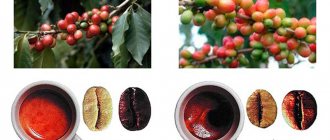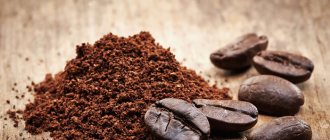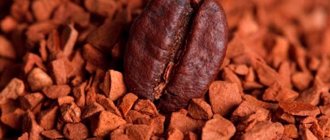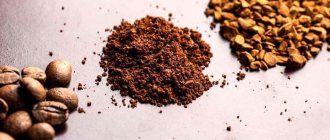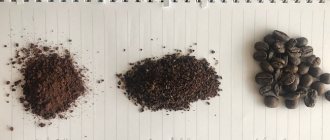The information on the package must be detailed.
Pay attention to what is written on the label.
If only the country is listed, you might want to look for another coffee. “Columbia” grain is too broad a term, and we need details! Remember what is usually written on wine bottles? Country, region, grape variety, vineyard name, harvest year... It’s a similar story with coffee. We want to see the country, region, tree variety, when the coffee was harvested, how it was processed - all of which influence the level of sweetness, acidity and flavor profiles.
Photo from Point Coffee&Food blog
Arabica or Robusta? And what is Liberica?
Yes, yes, we are used to hearing only the first two names, but in fact there are a little more of them. Let's explain.
These names are not coffee varieties or types, as many believe. Arabica, Robusta, Liberica, Excelsa are the 4 main varieties of trees (there are about 80 in total), and each of them has several varieties. Coffee lovers are interested in only two - Arabica and Robusta, since it is their beans that have the most pleasant and pronounced coffee flavor. The grains from these trees account for about 98% of world production.
In order not to get into the jungle of botany, we offer you a simple list of distinctive characteristics that are important when choosing coffee beans.
| Arabica | Robusta | |
| Bean shape | Large oval with curved groove | Small round with straight groove |
| Properties | Delicate aroma, softness | Thick coffee foam, strength |
| Caffeine | 1.1 — 1.7% | 2 — 4.5% |
| Taste | Rich, pronounced sweetish with sourness | Astringent with bitterness |
| Price | The trees are finicky to grow, so the price of the fruit is much higher | Trees bear fruit more often, do not require careful care, and the price of fruits is lower |
Robusta beans are used, as a rule, in the production of instant coffee and blends. Arabica is the main ingredient of single varieties. But it should be remembered that the country where the fruit is grown and climatic conditions can significantly influence the taste, and Brazilian Arabica will definitely differ from that produced in India. Brazil, Guatemala, Ethiopia, Kenya, and Colombia are considered the best coffee producers.
No flavorings!
High-quality grain cannot be flavored. Coffee is a self-sufficient product. Its taste depends on the terroir (the combination of soil-climatic factors and special characteristics of the area), the method of fermentation, roasting...
By the way, professionals use the word “descriptor” to indicate shades of tastes and aromas. On Flowwow you can find coffee with completely different flavor profiles: fruity, spicy, berry, nutty, floral.
Types of coffee - put on shelves
In this article we would like to outline the general principles for naming coffee varieties. We would like to note: the type of coffee is, for example, Jamaica Blue Mountain; Arabica or Robusta is a type of coffee.
The main criterion for the diversification of coffee varieties is the geography of their growth. That is, the first point in the name of any type of coffee is the country of origin: Uganda Robusta, Costa Rica Tarrazu, Yemen Matari. There are exceptions: Monsoon Malabar, for example, which is known to be harvested in India, or Kopi Luwak, which is known to be harvested in Indonesia (although recently this is no longer the case - see our article "The most expensive coffee in the world"). This practice can be called including a unique identifier in the name of a coffee variety. Another example is Brazil Bourbon, where the unique identifier is the variety of coffee.
So, so far we have built the following scheme for naming a coffee variety: country of origin + unique identifier. We would like to immediately note that the obligatory point in the name of a coffee variety is essentially only the country of origin. All other points are optional, but not mandatory.
Not long ago, the trend of additional geographical denomination of coffee varieties began to gain momentum, that is, the identification of additional regions within the country: Costa Rica Tarrazu (and not Tres Rios), Ethiopia Irga Cheffe (and not Sidamo), Yemen Matari (and not Sanani). In this case, the unique identifier can be the name of the farm: for example, Costa Rica Tarrazu La Pastora.
Next in the name of the coffee variety is technical information: growing height, processing method and grain size. For the meaning of this information, see our article “From Berry to Cup.” This information is coded differently depending on the country of origin of a particular coffee variety: Colombia Supremo, Guatemala SCB, Kenya AA. Let's look at these notations.
The height of growth of a coffee variety is indicated by the following designations: HB/SHB and HG/SHG, adopted in Central America. HB (Hard Bean) and SHB (Strictly Hard Bean) are used in Costa Rica and Guatemala, while the terms HG (High Grown) and SHG (Strictly High Grown) are used for Honduras, El Salvador, Nicaragua and Mexico.
HB and HG imply a growing height of 1200 to 1400 m, and SHB and SHG - from 1400 m.
Why is the growing height of a coffee variety important?
...but the 18th screen is much larger.
The higher coffee grows, the less oxygen there is in the atmosphere, and accordingly, the slower the ripening process occurs - as a result, the bean becomes the densest. Have you ever seen small crooked cows living in the mountains at an altitude of three kilometers? Coffee trees are the same. The densest beans gain the maximum amount of acidity, which is responsible for the taste characteristics of coffee, and therefore coffee that grows higher is valued more (hence the term “high-mountain”).
The size of the coffee bean is indicated by the following designations: for Colombian coffee varieties - Supremo and Excelso, for African coffee varieties, except Ethiopia (Kenya, Rwanda, Tanzania, Burundi, Malawi) - AA, A, AB, B, C. Regarding the size Coffee beans I would like to comment on two points. Firstly, the size of the coffee bean is called screen (from the English screen - screen, sieve). A screen is a sieve with holes of a certain diameter through which coffee beans are sifted to be sorted by size.
Of the designations we mentioned for specific varieties of coffee, Supremo is screen 17-20, Excelso is screen 15-16; AA – screen 18.5-20, A – screen 17-18, B – 15-16, C – 14.
| Screen | Mm |
| 20 | 8 |
| 19 | 7.5 |
| 18 | 7 |
| 17 | 6.75 |
| 16 | 6.5 |
| 15 | 6 |
| 14 | 5.5 |
| 12 | 5 |
Secondly, the effect of bean size on the taste of coffee is not as obvious as the effect of growing height. If a variety is usually ranked by size (for example, Uganda Robusta, Monsoon Malabar, Brazil Santos, Kenya), then often, but not always, larger size gives better taste: Santos 19 is better in taste than Santos 17, Kenya AA - Kenya C, but, for example, Uganda Robusta 17 is often better than Uganda Robusta 18, which is rather an exception to the rule. But! If a coffee variety is not customarily sorted by size, this does not mean that it is worse or cheaper! For example, Yemen or New Caledonia, which is the same price as Jamaica Blue Mountain, the grains of these varieties are small, but the taste characteristics of the cup are absolutely amazing. Conclusion: in the coffee world, size doesn't always matter!
The grain size is also indicated by the grade parameter for coffee varieties from Vietnam, Peru, and Jamaica Blue Mountain. For coffee varieties from Ethiopia, the grade indicates the processing method: 1 and 2 are washed processing, 3-5 are natural.
So, the name of a coffee variety is based on the following template: country of origin + additional geography + unique identifier + technical information. The use of all the terminology for the name of a coffee variety is appropriate in the professional community, but for the end consumer we consider these terms to be heavy-handed. That’s why we simply call coffee: Yemen, Costa Rica, Uganda Robusta. However, any coffee connoisseur will find its full name on our coffee variety page in the online store.
You can read about such an important taste characteristic of each variety as sourness in our article “Sour Coffee”, and the specifics of roasting are disclosed in the article “Roasting Coffee”.
We look at the appearance of the grains: light and without oil.
You can only see the quality of roasting at home by opening the pack. And it’s good if inside there are grains of a pleasant brown color, approximately the same in tone: a little darker or lighter, it depends on the roasting style. The main thing is that the grain is not very dark, close to black. This definitely means that the sugars were burned during frying, and the taste will be rancid and ashy.
If oil appears on the surface, this is also a bad sign. Proper frying will preserve all the oils inside. This will make the cup richer and much tastier!
Photo from Point Coffee&Food blog
Main types of coffee and their differences
The term “coffee varieties” refers to the different coffee trees that have been studied and described by botanists. There are about 40 such plants, and they have many differences in external characteristics and in the quality of beans.
The following types of coffee beans are used to make the aromatic drink:
- Robusta;
- Arabica;
- Liberica;
- Excelsa.
The most valuable and popular species from this list is Arabica, which is cultivated in 50 countries. Moreover, each region produces the same types of beans, but the finished drink has different taste and aroma qualities.
Arabica
This species is represented by a small tree, the height of which reaches 7 m. For convenience, on plantations it is cut to a level of 4 m. The fruits are elongated and convex, containing essential oils and caffeine in small quantities. The drink turns out aromatic and with a barely noticeable sweetness.
Arabica costs much more than other beans due to the specifics of cultivation. Plants are demanding on soil, often get sick, and grow on mountain slopes in places where there is no frost.
Arabica occupies 70% of the world coffee market and is represented by 45 varieties that are distinguished by an abundance of tastes and aromas.
Bourbon Santos is considered the best type from which beans and ground coffee are obtained. Arabica Burundi is in demand with a chocolate flavor, a sour aftertaste and a good strength of the drink.
One tree provides up to 5 kg of product, of which the weight of the finished coffee obtained by roasting is 1 kg. Fruit ripening is uneven. The ovaries formed after flowering grow and mature within 10 months. During this period, trees need to be watered, fertilized, and treated with pesticides to prevent diseases. The difficulty in growing trees lies in the fact that they reproduce using seeds.
Interesting! Recipes for making raf coffee, composition of the drink and various additives
Robusta
The first trees were discovered on African territory, near the Congo River. Robusta contains a large amount of caffeine, adding bitterness and strength to finished drinks. Robusta is not produced in single-varietal format due to its light aroma and weak taste.
Robusta accounts for 30% of world cultivation. The trees are not picky about weather conditions, are not afraid of drought and low temperatures, practically do not get sick, and reproduce by cuttings, so growing them is not difficult. Full ripening of the grains takes about 11 months. The best fruits are sent for blending, and instant coffee is produced from small and substandard grains. Robusta is often mixed with Arabica to produce a strong, bitter drink.
Liberica
The plant is common in Africa, is not afraid of diseases and grows up to 10 m in height. Fruits weakly, while the fruits are bitter and have a characteristic aroma. Liberica is less in demand compared to previous varieties. But adding a small amount of Liberica to the coffee mixture creates an interesting bouquet of flavors.
Excelsa
This species is considered the rarest and most expensive. The plant reaches up to 20 m in height, which is why it is also called Tall. Excelsa is the most delicious type of grain, with a deep taste and rich aroma. Gourmets are willing to pay big money to enjoy this drink.
The best Excelsa variety is the “soft Colombian”, which is harvested by hand.
Universal roast
Medium roast, or, as it is also called, universal roast, is the ideal option. This is how grains brought from Ethiopia, Costa Rica, Colombia and Brazil are roasted.
Medium heat treatment also has its own degrees:
- Full urban. This roasting is done until the second pop. During processing, oily droplets appear on the beans. But the drink made from such grains has an amazing aroma and a certain viscousness.
- French, velvet or Viennese. The beans are roasted until dark brown, causing smoke from the burning oils to appear above them. The drink made from such grains is very strong and rich, with a characteristic bitterness.
Packaging of grains
When you come to the store, having the knowledge of how to choose good coffee beans, you can safely begin to search for a suitable option. The range of goods in supermarkets is quite impressive. What should you pay attention to when making your choice? Of course, on the packaging. It is this that is very important for maintaining the quality of the product.
Currently, there are several packaging options on the coffee market. One of them is paper bags. They are used to pack beans purchased in coffee shops or coffee shops. Purchasing goods in such places is an excellent option, but you should not take more than 200 grams, since grains are stored in such packaging for no more than two weeks. This means it’s always better to take a portion of fresh ones.
Vacuum packaging
Vacuum packaging can be made in two versions - cans and pacts. How to choose quality coffee beans if it is already packaged? You should focus specifically on the quality of the packaging material. After all, its main task is to protect the grains from exposure to air. If the beans come into contact with the environment, they will react and lose their original taste.
The most popular is gas-filled packaging with a vent valve, which allows vapors to escape, but at the same time air does not get inside. The valve allows you to feel the aroma of the beans after pressing the pack. In such an airtight package, coffee can be stored for 18 to 24 months. The packs are made of durable material that should not tear at the folds. Sealed bags with valves and jars are used by those companies that value their reputation. Most enterprises package grains in cheaper bags with foil. Now, knowing how to choose packaged coffee beans, you can easily navigate a large assortment of products.
Cost of coffee
Which inexpensive good coffee beans should you choose? Any barista will tell you that in this case it is not worth saving. The higher the price, the better quality drink you will get. This statement clearly applies to elite species. Good coffee can't be cheap. Rather, on the contrary, the low cost should raise doubts about the origin of such grains. The most avid coffee lovers prefer elite varieties.
However, ordinary people, as a rule, pay attention to a product of average cost. In this price category you can also find quite decent coffee. Any barista recommends purchasing beans from a specialty store. Of course, this is not a guarantee that you will not come across a low-quality product, but still, in such places, sellers can help in choosing.
In addition, in such places the coffee does not come into contact with foreign goods, the odors of which can negatively affect the aroma of the coffee. In specialized places you will be offered a larger selection of mixtures and varieties. In addition, you will have the opportunity to visually look at the beans and smell their aroma. To prepare a quality drink, you need freshly roasted coffee, which has been stored in accordance with the standards. In supermarkets, they do not pay attention to this fact, and in specialized outlets the beans are stored in containers that allow them to preserve all their properties.
Deep roast
Strong roasting gives the beans a dark brown hue. The drink made from such grains has a very rich aroma and a noticeable bitterness. Brazilian varieties, Cuban and Guatemalan Robustas and Arabicas are roasted in this way.
There is also a dark roast, it is also called Mexican, Cuban or Spanish. There is practically no water left in the grains after heat treatment. Boba is used to make blends to create a new flavor palette.
But Italian roasting is used to prepare espresso blends. The beans are first deeply fried and then blasted with air. After this, the grains remain open to rest, since carbon dioxide is still actively released from them. The coffee is then packaged in paper bags with foil. It is this packaging that inhibits the oxidation process and allows you to maintain an acceptable level of humidity.
Knowing all the options for processing coffee beans and focusing on your preferences, in the store you will not have a question about which coffee beans to choose.


